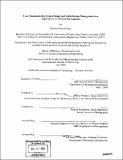| dc.contributor.advisor | Daniel Whitney and Donald Rosenfield. | en_US |
| dc.contributor.author | Gates, Matthew David, 1973- | en_US |
| dc.contributor.other | Leaders for Manufacturing Program. | en_US |
| dc.date.accessioned | 2006-11-08T16:30:58Z | |
| dc.date.available | 2006-11-08T16:30:58Z | |
| dc.date.copyright | 2004 | en_US |
| dc.date.issued | 2004 | en_US |
| dc.identifier.uri | http://hdl.handle.net/1721.1/34746 | |
| dc.description | Thesis (M.B.A.)--Massachusetts Institute of Technology, Sloan School of Management; and, (S.M.)--Massachusetts Institute of Technology, Dept. of Mechanical Engineering; in conjunction with the Leaders for Manufacturing Program at MIT, 2004. | en_US |
| dc.description | Includes bibliographical references (p. 156). | en_US |
| dc.description.abstract | Value Stream Mapping is a powerful tool for identifying sources of waste and for creating the vision for the future state of a production system. As a management tool, however, it lacks in specific focus of roles, responsibilities, and actions required to achieve the future state vision. The limitations become more evident and the problems of execution become exacerbated when multiple value stream projects are launched with limited human resources available. This thesis describes a set of management tools to complement Value Stream Mapping. The tools are expected to improve management visibility and accountability. The design of a lean production system is also proposed in this thesis. The lean production system includes a newly designed layout for the manufacturing cell as well as the "operating system" for the cell. The layout is based on the principles of cellular manufacturing in order to promote flow and improve quality. The operating system includes such things as production batch sizes, product routings, and strategic inventory locations. Based on the future state value stream map and supported by a discrete-event simulation, the new operating system is designed to align the lean strategy with the technical capabilities of the manufacturing line. As confirmed by the simulation, implementation of the new production system is expected to reduce lead time for the cell by 2/3, realize a corresponding one-time reduction in inventory of $350,000, and increase on-time delivery of the cell to over 97%. In total, the project has a three-year net present value exceeding a quarter of a million dollars. | en_US |
| dc.description.statementofresponsibility | by Matthew David Gates. | en_US |
| dc.format.extent | 156 p. | en_US |
| dc.format.extent | 8235862 bytes | |
| dc.format.extent | 8253460 bytes | |
| dc.format.mimetype | application/pdf | |
| dc.format.mimetype | application/pdf | |
| dc.language.iso | eng | en_US |
| dc.publisher | Massachusetts Institute of Technology | en_US |
| dc.rights | M.I.T. theses are protected by copyright. They may be viewed from this source for any purpose, but reproduction or distribution in any format is prohibited without written permission. See provided URL for inquiries about permission. | en_US |
| dc.rights.uri | http://dspace.mit.edu/handle/1721.1/7582 | |
| dc.subject | Sloan School of Management. | en_US |
| dc.subject | Mechanical Engineering. | en_US |
| dc.subject | Leaders for Manufacturing Program. | en_US |
| dc.title | Lean manufacturing system design and value stream management in a high-mix, low-volume environment | en_US |
| dc.type | Thesis | en_US |
| dc.description.degree | S.M. | en_US |
| dc.description.degree | M.B.A. | en_US |
| dc.contributor.department | Leaders for Manufacturing Program at MIT | en_US |
| dc.contributor.department | Massachusetts Institute of Technology. Department of Mechanical Engineering | |
| dc.contributor.department | Sloan School of Management | |
| dc.identifier.oclc | 56606388 | en_US |
